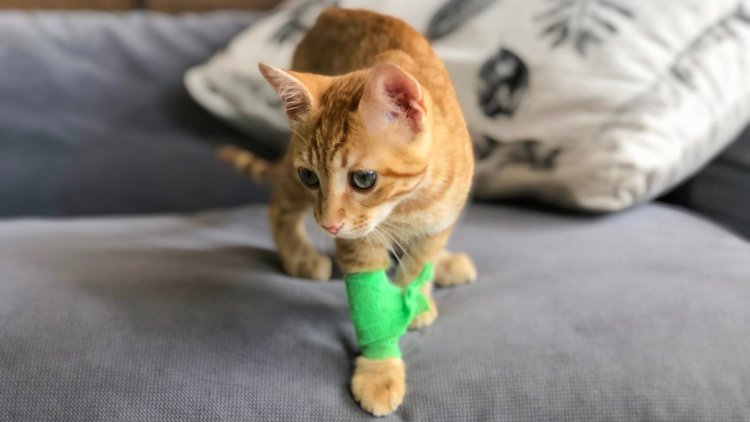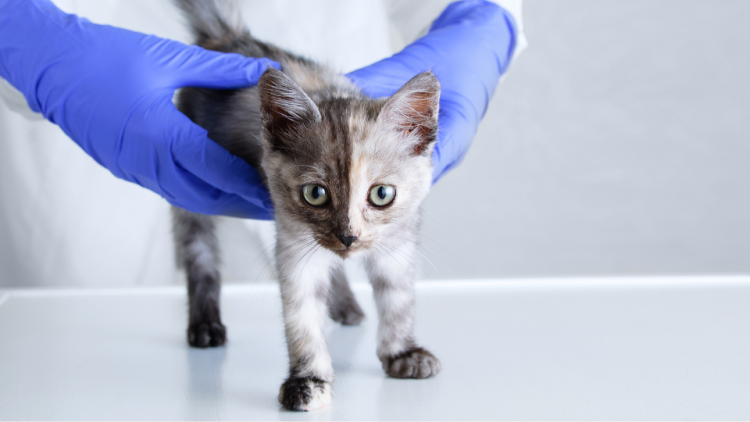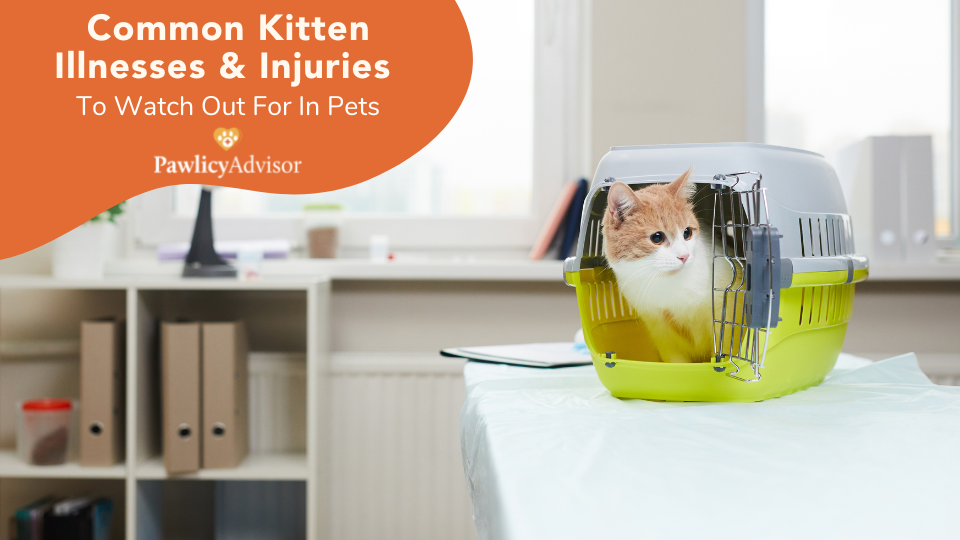Keeping your new kitten safe and healthy can often feel like a challenge. Young cats are quite playful and curious, which often leads to injuries. In addition, just like any baby animal whose immune system isn’t fully developed, kittens are susceptible to a number of diseases.
Protect Your Kitten with Pet Insurance Common Health Issues in Cats by Breed & Age
In this article, we’ll help you recognize the most common symptoms of kitten illness and show you what to do if your new four-legged friend gets ill or injured.
Use the links below to jump ahead to information on common kitten illnesses and injuries:
- What Are Common Kitten Illnesses?
- Common Kitten Injuries, Accidents, and Medical Emergencies
- Kitten Diseases Acquired at Birth
- Prevalence of Kitten Disease by Breed
- Treatment Costs For Disease in Kittens
- Key Takeaways
- FAQs on Kitten Disease
What Are Common Kitten Illnesses?
1. Parasitic Infection
Intestinal worms
Intestinal worms like hookworms, tapeworms, ringworms, Coccidia, and Giardia are prevalent in kittens. Many kittens get these worms in the mother’s womb, through the mother’s milk, or through contact with a contaminated environment. Kitten illness symptoms include:
- Diarrhea
- Vomiting
- Weight loss
- Abdominal pain
Your vet will be able to recommend dewormers for intestinal worms and heartworm in cats.
Fleas
Fleas can infect cats of all ages, but a heavy flea infestation can lead to potentially fatal anemia in small kittens. They can spread diseases like Mycoplasma and Bartonella. Getting rid of fleas includes regular flea medication, treating all other pets, and environmental control. Your vet will recommend the best type of flea prevention based on your kitten’s needs.
Ear mites
These parasites infest your kitten’s ears and are more common in cats under one year of age. Symptoms of ear mites in cats include brown or black discharge from the ears, scratching at the ears, shaking of the head, and inflammation of the ear canals.
Your vet will prescribe suitable medications to eliminate the mites. Be sure to follow the dosage instructions when administering the drug to avoid any unwanted side effects.
2. Vomiting and diarrhea
Vomiting and diarrhea may be due to any number of reasons, including:
- The stress of rehoming
- Internal parasites
- Bacterial infection
- Viral infections
- Changes in diet or dietary indiscretion
- Toxins
- Vitamin deficiencies
- Congenital diseases.
Small bouts of diarrhea are treatable at home through a bland diet. However, if your kitten displays symptoms like lethargy, bloated abdomen, bloody diarrhea, or doesn’t respond to the bland diet, they should be seen by a vet.
3. Upper Respiratory Infection (URI)
Upper respiratory infection is the most common kitten disease, especially among kittens in shelters. Symptoms include sneezing, runny nose, runny eyes, lethargy, and decreased appetite. With good nursing care, most kittens will recover from a URI within one to two weeks, but it can result in chronic cat asthma in some cats. If your pet fails to improve, you’ll need to make an appointment with your vet.
4. Urinary Tract Infection (UTI)
About three percent of cats are likely to develop UTIs. The most common signs of a urinary tract infection include frequent urination, straining to urinate, blood in the urine, and urinating outside the litter box. If you notice your kitten has any of these symptoms, be sure to seek veterinary care. The average cost to treat a UTI is from $200 to $400.
5. Urinary Blockages
In some cases, a UTI can develop into a secondary condition known as a urinary blockage. The symptoms of a urinary blockage are similar to those of a urinary tract infection, but you might also notice an inability to urinate or your pet vocalizing in the litter box. If you see these clinical signs in your kitten, make an appointment with your vet.
Common Kitten Injuries, Accidents, and Medical Emergencies

1. Soft tissue strains and sprains during play
Kittens can get strains and sprains due to overly rambunctious play or incorrectly jumping onto or falling off a surface. The most common signs of soft tissue injury include:
- Bruising
- Swelling
- Lameness
- Whimpering
- Excessively licking the injured part of the body
If the symptoms are mild, refraining from vigorous activity and play should be enough for your kitten to heal. However, see your vet if their condition doesn’t improve or if you notice continued limping and swelling.
2. Fractured bones and trauma upon impact
Kittens and cats usually, but not always, land on their feet. Kitten injuries from falls can be severe, including broken bones, collapsed lungs, head trauma, etc. Kitten injuries can also be attributed to their small size, making them prone to being squished or stepped on. \
The average cost to treat a broken kitten bone ranges from $1,500 to $4,000, depending on the complexity of the surgery.
3. Foreign object ingestion
Because kittens explore the world with their mouths, they can often swallow things they aren’t supposed to, such as string and wool. If a foreign object gets lodged into your kitten’s gastrointestinal tract, it can create a life-threatening intestinal blockage.
In that case, you might notice your cat is more sleepy than usual, in addition to symptoms such as:
- Diarrhea
- Vomiting
- Abdominal pain
Kittens who have ingested a foreign body and display symptoms of a potential intestinal blockage should go to the pet emergency room right away.
The cost to diagnose intestinal blockages in cats ranges between $500 and $1,000 at an emergency vet, and surgery to remove the cat’s intestinal blockage costs $1,000 to $3,500 depending on the complexity of the surgery, where you live, and which hospital you visit.
4. Bite wounds
Unfortunately, young kittens are very vulnerable to attacks from predators, neighboring pets, and other dogs/cats in the home. If your kitten suffers a bite wound, your veterinarian will likely prescribe antibiotics to treat or prevent abscess formation, which can be a time-consuming and uncomfortable healing process in pets.
5. Anaphylaxis
Anaphylaxis is a severe allergic reaction that can be life-threatening. Insect stings or adverse drug reactions typically trigger it. If your kitten was stung by an insect and shows signs of swelling, pain, or lameness, take them to the vet immediately.
Reactions to vaccines and medications usually include milder symptoms, such as itchiness and lethargy. However, if you notice symptoms like vomiting after receiving the administered dosage, failure to respond to touch or sound, or signs of seizure/tremors, take your pet to the emergency vet.
Kitten Diseases Acquired at Birth
Also known as congenital conditions in pets, some kitten diseases already exist at the time of birth. Some pet defects are merely cosmetic (such as polydactyl cats born with extra toes), while others might create a physical impairment, like walking with a limb.
However, other kitten diseases inherited at birth can have profound implications, including death. Therefore, it’s critical to watch your pet’s development to detect possible symptoms of congenital conditions in kittens.
Here are some of the most common congenital kitten diseases to be aware of:
1. Hydrocephalus
Hydrocephalus, also known as “water on the brain,” is a congenital condition that blocks the outflow of cerebrospinal fluid (CSF). Symptoms vary depending on the severity of the condition but may include an oddly dome-shaped skull, hyper-excitability, eyes that point outward and downward, head pressing, spastic or irregular gait, circling, hearing or visual impairment, and seizures.
Treatment may include medications to decrease CSF production or increase its absorption and anti-seizure medicines when necessary. If a malformation or tumor causes the condition, it might require surgical removal.
2. Cardiac conditions
Most heart disorders are diagnosed in middle-aged and senior cats, but some kittens are born with them. The most common cardiac conditions in kittens are mitral valve dysplasia (MVD), patent ductus arteriosus (PDA), and ventricular septal defect (VSD). Fortunately, these congenital cardiac diseases are relatively rare, affecting only one to two percent of kittens.
Many kittens with congenital heart conditions will respond favorably to treatment or surgery and can be expected to have an average lifespan. However, in the case of severe congenital cardiac defects, the prognosis is very often poor.
3. Eyelid defects
Congenital defects of the eyelids can be evident in a kitten shortly after birth or might develop within the first six to eight weeks of life. Some of the most common ones include:
- Entropion - turning in of the eyelid’s edges, so the eyelashes rub against the eye surface
- Ectropion - a slack eyelid edge that’s turned out, typically with a large notch in the eyelid
- Lagophthalmos - an inability to fully close the eyelids and protect the cornea from trauma and drying
Treatment will depend on the specific type of abnormality affecting your kitten. Medications or eye drops can be used to mitigate the effects of some types of defects, and surgery can repair some congenital eyelid defects.
4. Flat-chest syndrome
Flat-Chested Kitten Syndrome (FCKS) is when kittens develop a thoracic deformity, causing their chest to appear flattened. Affected kittens present with symptoms like difficulty breathing and failure to gain weight.
Most kittens with flat-chests remain active and bright unless severely affected. In most felines that survive, the defect will become less obvious as they grow and is frequently unnoticeable in adult cats.
5. Feline immunodeficiency virus (FIV)
FIV can be acquired at birth from the mother or through nursing. Felines infected with this virus may not show any signs of illness until years after the initial infection starts. However, once the virus takes hold, the cat’s immune system will be seriously compromised. The most common symptoms include:
- Enlarged lymph nodes
- Weight loss
- Fever
- Diarrhea
- Poor appetite
- Inflammation of the mouth, gums, or eyes
- Dental disease
Prevalence of Disease in Kittens by Breed

Inherited diseases can occur in both non-pedigree and pedigree cats but are generally more prevalent in purebreds. **A recent study on congenital disease in kittens found the following breeds to be most affected:
- “Contemporary” American Burmese (80% kittens affected)
- Tonkinese (31%)
- Manx (19%)
- Colorpoint Shorthair (17%)
- Persian (12.7%)
- Devon Rex (6%)
- Norwegian Forest Cat (5%)
- Burmese (4.2%)
Treatment Costs For Disease in Kittens
Unfortunately, many people who get a kitten don't expect their free rescue or expensive pedigree to have ongoing bladder issues, respiratory ailments, or congenital disorders, for example. While budgeting for a cat's occassional sickness may be easy enough to manage, these types of chronic conditions require ongoing vet appointments, prescription medications, specialty pet products, and routine testing — all of which can amount to thousands of dollars in care costs the course of their pet's lifetime.
And, even if you're extremely careful to kitten-proof your house, accidents are always a possibility given the amount of safety hazards for indoor cats lurking around every corner. If your pet were to accidentally injure themselves (as kittens are often prone to do), the cost for treatment can quickly exceed a thousand dollars or more in a single emergency vet visit.
To offset the financial burden of caring for a kitten and ensuring they always have access to essential healthcare, pet insurance can be a significant help. Learn more about why pet insurance is worth it for cats and how you can get reimbursed for your kitten's future vet bills by signing up today.
Protect Your Kitten with Pet Insurance How Does Pet Insurance Work?
Key Takeaways
- Several common kitten illnesses to look out for include parasitic infections, upper respiratory infections, and urinary tract infections. Some diseases may already exist at birth, i.e., congenital conditions such as hydrocephalus, flat chest, and eyelid deformities.
- Small kittens are also quite prone to injuries. The most common ones are soft tissue strains and sprains, fractured bones, bite wounds, foreign object ingestion, etc.
- Staying up-to-date with the vaccines and recognizing the symptoms of these common illnesses can help prevent your pup from getting seriously ill.
- If you suspect that your kitten is sick or injured, get in touch with your vet.
FAQs on Kitten Disease
How can you tell if a kitten is sick?
Generally, kitten illness symptoms include diarrhea, vomiting, decreased appetite, increased thirst, lethargy, weight loss, sudden change in mood, rapid breathing or shortness of breath, etc.
How to check for kitten injuries from a fall?
If your kitten fell and got injured, they will have sore limbs, swelling, and will often limp and may avoid walking on the injured limb. You may also notice that your kitten is excessively licking the wounded area. Have a pet first aid at hand to help your kitten as you prepare to take them to the vet.
What kitten diseases are fatal?
The most dangerous feline diseases include Feline Leukemia Virus (FeLV), Feline Immunodeficiency Virus (FIV), Feline Panleukopenia (Distemper), kidney disease/renal failure, and rabies.
